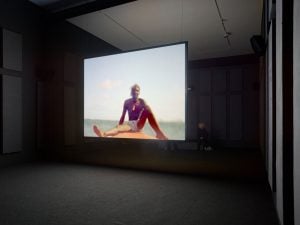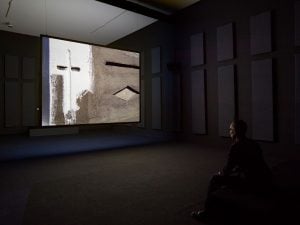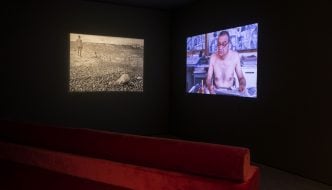Steve McQueen’s double-sided video projection tells the story of Ashes – an ostensibly carefree youth who becomes fatally entangled in the plights of the Grenadian drugs trade.

Courtesy of The Whitworth Gallery
On one side of McQueen’s video installation, Ashes, an athletic young Caribbean man sits on the prow of a fishing boat, gently rocking in the swell. Aware of the Super-8 camera that captures him, the seemingly untroubled youth plays up to his natural allure, posing for the viewer as idle subject in a pair of faded light blue shorts. The eponymous Ashes has a sort of confidence and insouciance, which is completely magnetising – one cannot help but fall under his spell-binding charm as he lounges and sunbathes on the boat’s small deck. On one occasion, Ashes – with an almost intentional clumsiness – lets go of the fishing boat’s painter and falls into the ocean. This only has the effect of exaggerating the playful flirtation of the footage, shot by Dutch cinematographer Robby Müller. Ashes is hyper-aware of being Müller’s muse for the day, and there is a sense of exuberance to Ashes’ behaviour as he exaggerates his carefree abandon for the sake of the camera.
McQueen organised this captivating footage of Ashes to be shot by Müller whilst filming for his 2002 video projection Carib’s Leap. Since the capturing of this film, the 1999 Turner Prize-winning artist’s career has truly flourished in its capacity as big budget film director. McQueen is most renowned for his incredibly poignant 2013 film adaption of Solomon Northup’s 12 Years a Slave. A slave narrative memoir which made McQueen the first black filmmaker to take home the Academy Award for best picture. However, in all the acclamation that has followed McQueen in his incredible career path to date, the footage of Ashes that never made it into Carib’s Leap managed to remain deeply lodged in some buried away compartment of his conscience, only to resurface 12 years later – when McQueen travelled back to Grenada, birthplace of both his parents, to discover that Ashes had been shot after stumbling across and stealing hidden narcotics on the beach. The perpetrators of this crime buried Ashes in an unmarked grave.
McQueen’s discovery of Ashes’ fatal mix-up in the Grenadian drugs trade prompted a sense of duty to document the plights of the young fisherman’s story, and engage a wider audience into the despair that surrounds drugs trafficking. The second side of the double-sided projection chronicles Ashes’ disturbing fate – depicting two experienced gravediggers going through the meticulous process of preparing an empty tomb, with the sort of detachment and indifference of men who have buried a thousand men before. The video installation is bought together by a unifying soundtrack. An elegy telling Ashes’ story is layered over the natural background sounds from the two separate videos. The harsh scratches from the engraving of the tombstone and the raw cracks of the gravediggers hammer cut through the calming and placid sounds of the ocean.

Courtesy of The Whitworth Gallery
The dichotomy created by McQueen’s installation pushes the boundaries of video as an artistic medium. The idealised wantonness, and vigour within the halcyon days of Ashes’ youth are beautifully represented by the soft, grainy textures of the Super8. The slight sense of debauchery and over-indulgence that is created by this softness is cleverly contrasted by the somewhat sharper 16mm film format – used to document the preparation of the young fisherman’s tomb. This juxtaposition snaps the viewer out of the hypnotic, and dream-like qualities of the 2002 footage, and back into the harsh realities of life in land. McQueen draws attention to the threats of inhabiting a black male body – shining a spotlight on the needless violence, and wasteful deaths of young Caribbean men.
There has been an interesting curatorial decision to put the posthumous side of the installation on entry to the exhibition. Reversing the chronology in this way prompts the viewer to dwell over the loss of an anonymous life, before being confronted by the identity of Ashes himself. The exhibition is accompanied by free posters, which have circulated Ashes’ story into many Manchester homes. The circulation of these posters allow the viewer to spend time thinking about what Ashes could have been, lamenting the loss of this captivating young man’s life.
Filed under: Art & Photography, Politics
Tagged with: Ashes, Grenada, installation, McQueen, video, Whitworth Gallery



Comments